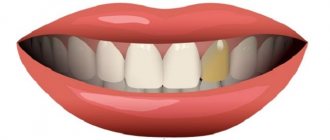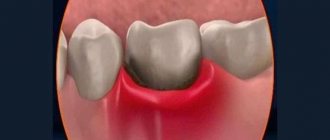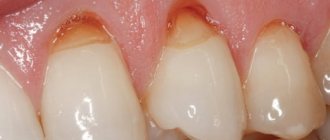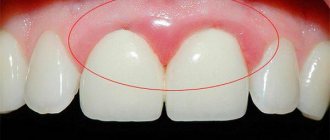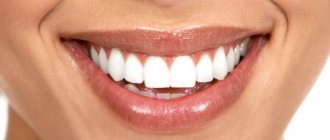Today, many patients when visiting dentistry complain about the loss of the natural shade of tooth enamel. Why does enamel become dull and lose its natural color? There are actually a huge number of reasons, and it is to them that we will pay attention today, but a little further. Now we note that this problem can be dealt with using modern teeth whitening technologies, Zoom whitening, Brite Smile, Opalescence, which are successfully used in medical science.
Changing the color shade of tooth enamel: varieties
There are two types of loss of natural tooth enamel color:
- Internal change. Occurs in the inner part of the tooth structure - dentin. The tooth becomes covered with gray, yellow spots or darkens.
- External change. The process takes place in the outer layer; deterioration is indicated by the appearance of yellow spots, white stripes, and dips on the surface of the tooth.
It is worth noting that external discoloration can be treated with special whitening technologies. Internal change is more difficult to cure. Its treatment may require aesthetic methods, such as veneers.
Features of baby teeth
The first teeth of babies have porous, thin enamel, which cannot effectively resist the attack of harmful microorganisms. The pulp cavity is wide. Once bacteria gets inside, they spread quickly. If a child has a weakened immune system, the pathogenic process affects the “neighbors.” Carious lesions are possible even in a one-year-old baby. We are talking about the so-called “bottle” caries, when the baby falls asleep while feeding. The sweet mixture remaining in the mouth creates favorable conditions for the development of pathogenic microflora.
Since caries in children progresses quickly, after some time the dentin is damaged. A carious cavity forms inside. But there is not always a visible stain on top. Blackening of the tooth from the inside may occur. Various factors contribute to the development of caries:
- insufficient hygiene is a common occurrence in children;
- genetic predisposition;
- poor nutrition, including excessive consumption of sweets;
- the influence of negative factors during the formation of teeth in the embryo - previous illnesses of the pregnant woman, taking certain medications.
Saliva has antibacterial properties and helps neutralize bacteria. In children this function is not as pronounced as in adults. She is also depressed by non-compliance with hygiene rules and a large amount of sweets in the diet.
The main reasons for changes in the shade of tooth enamel
- Consumption of food and drinks. Internal spoilage can occur from eating a wide variety of foods if proper oral care is not maintained.
- Tobacco use causes damage to the outer layer of tooth enamel.
- Inadequate dental care. If you do not brush your teeth regularly or with low-quality toothpastes, there is a risk of discoloration of the enamel.
- Use of medications. Any medications for high blood pressure can affect your dental health. If a pregnant woman uses tetracycline antibiotics, there is a risk of loss of color of the enamel and the newborn.
- Diseases. There are some infections in pregnant women that can affect the color of the newborn's tooth enamel, and teeth can also lose their natural color in case of dentin disease.
- The presence of dentures in the case of using silver amalgam during care can give the enamel a grayish tint.
- Genetic predisposition.
- Aging. As you age, tooth enamel may become yellowish. Also, soft or hard plaque may form on the surface of the teeth, which also causes discoloration of the teeth.
- Medical procedures. There are procedures, for example, chemotherapy, in which one of the side effects is the effect on the color of tooth enamel.
Most often, a person can cope with the problem, especially if it is caused by an external discoloration. All that is required is regular visits to the dental office and proper hygiene using quality toothpastes.
Immediately after eating food or drinks (red wine, tea, coffee), it is recommended to immediately rinse your teeth with water, but it is better to brush your teeth with toothpaste. After smoking, it is also necessary to brush your teeth, otherwise an unpleasant yellowish tint may appear on the tooth enamel in the near future.
Tooth pigmentation - symptoms and treatment
A doctor can make a diagnosis of “teeth pigmentation” by collecting all the necessary data after a survey and examination. If necessary, additional studies are performed.
In modern medicine, there are not many methods for diagnosing tooth pigmentation, so choosing the right one is not difficult. These include:
- visual inspection of clinical manifestations;
- radiography - allows you to evaluate the internal structure of the tooth and identify deviations;
- computed tomography (CT) is a fairly modern research method that is beneficial for both the doctor and the patient (the doctor receives a higher quality image, and the patient receives approximately 90% less radiation); allows you to study the image in 3D format and monitor the dynamics of treatment;
- microscopy - magnifies the area under consideration approximately 25 times, makes it possible to study the structure of the enamel and the extent of the lesion;
- rheodentography - allows you to determine the functional abilities of the pulp, as well as assess the depth of the lesion;
- electroodontodiagnosis is a method of studying the condition of the pulp and periodontium (soft tissues surrounding the root of the tooth) using a dosed electric current that affects the nerve without damaging the tissue membrane of the pulp [8][9].
As a rule, to diagnose ordinary pigmentation, it is enough only to collect complaints, an anamnesis (history of the disease) and a visual examination. Doctors resort to more serious studies, such as CT scanning and a microscope, in case of deeper lesions of the dental cavity and periodontium.
To choose the right treatment method, it is very important to establish a correct diagnosis and not confuse a pigment spot with caries. The latter, unlike dark pigmentation, has a cavity bottom that is not only dark, but also loose.
Superficial caries must also be differentiated from a whole group of non-carious tooth lesions, such as enamel hypoplasia, fluorosis, wedge-shaped defect, erosion and necrosis of hard dental tissues.
With caries, the spot is most often a single one. It is localized in the grooves on the chewing surface or one of the contact surfaces (between the teeth), less often on the neck of the tooth. With hypoplasia and fluorosis, the spots are multiple and localized in places atypical for caries: areas of the labial (cheek) and lingual surface of the tooth crowns.
Spots with hypoplasia are usually white with clear boundaries and have a smooth and shiny surface. They are located at the same level of the crowns of several symmetrically located teeth.
Dental abnormalities that may cause discoloration of tooth enamel
Changes in tooth color can occur as a result of changes in their size or shape. The color of the tooth may change depending on the number of teeth and the period of eruption.
Complete edentia is extremely rare, but the absence of several teeth is a common pathology. It is explained by endocrine disorders, which can cause a delay in teething and, as a result, a change in color.
With tuberculosis, neurological diseases, rickets, retention of the molars, as well as the upper canines (permanent), occurs.
In diseases associated with osteogenesis, patients most often have small teeth and a bluish tint to the tooth enamel. It is worth noting that the teeth of people with such diseases wear out quickly and are especially susceptible to disease. Pathologies in the development of dental dentin and tooth enamel cause amber, opal, bluish and brown tints of teeth and insufficient size.
Methods to combat tooth staining
Today, there are many options for teeth whitening in dental practice. Patients often try to whiten enamel at home, using cheap and very aggressive means - citric acid, activated carbon, hydrogen peroxide solution. The specialists at Dr. Granov’s dental clinic strongly do not recommend that you engage in such “amateur activities.” The maximum you can achieve using these methods is a slight lightening of 0.5-1 tone, and only if you regularly use the recipe. In this case, your enamel will suffer catastrophically - it will become thin, fragile and hypersensitive. The only acceptable method of dealing with teeth staining at home is the use of professional solutions and whitening toothpastes. Consult a specialist regarding the selection of such a product. In our clinic you can access the following services:
- Whitening “Air Flow”;
- Whitening "ClinPro";
- Teeth whitening “Opalescence”;
- Whitening “ZOOM3”;
- Whitening using laser equipment.
We also provide a professional ultrasonic cleaning service, which can make your teeth 1-2 shades lighter, returning them to their natural whiteness. Sometimes this is enough to achieve results. Our specialists offer their patients the service of selecting home whitening products (trays and solutions). In some cases, non-invasive whitening is not enough, and the dentist may offer you artistic restoration methods (veneering, lumineering, etc.). If you want to find out the reason for the staining of your teeth, or want to get rid of the problem of yellowing of the enamel, we invite you to an in-person consultation at our clinic.
How to restore the color of tooth enamel?
In many cases, with the exception of diseases and pathologies, patients have every chance to influence and change the color of tooth enamel for the better, without even going to the dentist. The surest way is to eliminate all foods and drinks that contain food colorings.
In difficult cases, various modern technologies, professional teeth cleanings help restore whiteness, and in the most difficult cases, prosthetics are performed.
There are many ways to restore the natural color of enamel; by contacting our center, each patient can count only on quality, namely the complete restoration of tooth enamel.
How to keep your teeth white
To keep your teeth white, you need to:
- Perform good oral hygiene, including brushing, flossing, and using mouth rinse
- Using a waterpik at least twice a week to get rid of plaque
- Once or twice a year, have your mouth professionally cleaned by a dental hygienist to remove tartar.
- Limit or eliminate smoking, strong tea and coffee
It is also important to make regular visits to the dentist for diagnostic procedures. This will allow timely identification of problems and identification of deterioration of the enamel.
Consequences of a tooth bruise
Darkening of the dentition provokes psychological discomfort, especially if these are the front teeth. Any injury does not go away without a trace. The tooth can be dislocated, cracked, broken, or sometimes embedded in the gum. Even if at the time of treatment the determination of the vital activity of the pulp gave a positive result, after the end of therapy it can still gradually die. This process is accompanied by damage to nerve endings, which provokes inflammation. More serious complications are also possible:
- cyst formation;
- manifestation of periodontitis;
- stopping root development.
These unpleasant consequences are possible in both baby and permanent teeth. Advanced pathology can even lead to tooth loss.
The rudiment of a permanent tooth often suffers from injury to a baby tooth. His enamel may develop poorly, and the risk of hypoplasia formation increases. The rudiment sometimes even dies.
